Related Research Articles

Snowboards are boards where the user places both feet, usually secured, to the same board. The board itself is wider than most skis, with the ability to glide on snow. Snowboards widths are between 6 and 12 inches or 15 to 30 centimeters. Snowboards are differentiated from monoskis by the stance of the user. In monoskiing, the user stands with feet inline with direction of travel, whereas in snowboarding, users stand with feet transverse to the longitude of the board. Users of such equipment may be referred to as snowboarders. Commercial snowboards generally require extra equipment, such as bindings and special boots which help secure both feet of a snowboarder, who generally ride in an upright position. These types of boards are commonly used by people at ski hills, mountains, backcountry, or resorts for leisure, entertainment, and competitive purposes in the activity called snowboarding.

Snowboarding is a recreational and competitive activity that involves descending a snow-covered surface while standing on a snowboard that is almost always attached to a rider's feet. It features in the Winter Olympic Games and Winter Paralympic Games.
A flange is a protruded ridge, lip or rim, either external or internal, that serves to increase strength ; for easy attachment/transfer of contact force with another object ; or for stabilizing and guiding the movements of a machine or its parts. Flanges are often attached using bolts in the pattern of a bolt circle.

Ice skates are metal blades attached underfoot and used to propel the bearer across a sheet of ice while ice skating.

Inline skates are boots with wheels arranged in a single line from front to back, allowing a skater to roll along on these wheels. Inline skates are technically a type of roller skate, but most people associate the term roller skates with quad skates, another type of roller skate with a two-by-two wheel arrangement similar to a car. Quad skates were popularized in the late 19th and early 20th centuries. Inline skates became prominent in the late 1980s with the rise of Rollerblade, Inc., and peaked in the late 1990s. The registered trademark Rollerblade has since become a generic trademark due to its popularity. To this day, "rollerblades" continues to be used in everyday language to refer to inline skates.

Telemark skiing is a skiing technique that combines elements of Alpine and Nordic skiing, using the rear foot to keep balance while pushing on the front foot to create a carving turn on downhill skis with toe-only bindings. Telemark skiing is named after the Telemark region of Norway, where the discipline originated. Sondre Norheim is often credited for first demonstrating the turn in ski races, which included cross country, slalom, and jumping, in Norway around 1868. Sondre Norheim also experimented with ski and binding design, introducing side cuts to skis and heel bindings.
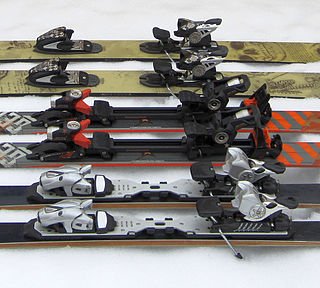
A ski binding is a device that connects a ski boot to the ski. Before the 1933 invention of ski lifts, skiers went uphill and down and cross-country on the same gear. As ski lifts became more prevalent, skis—and their bindings—became increasingly specialized, differentiated between alpine (downhill) and Nordic styles of skiing. Until the point of divergence in the mid-20th century, bindings held the toe of a flexible, leather boot against the ski and allowed the heel to rise off the ski, typically with a form of strap or cable around the heel.
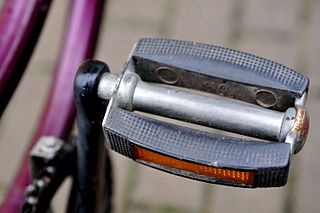
The pedal is the part of a bicycle that the rider pushes with their foot to propel the vehicle. It provides the connection between the cyclist's foot or shoe and the crank allowing the leg to turn the bottom bracket spindle and propel the bicycle's wheels. A pedal usually consists of a spindle that threads into the end of the crank, and a body on which the foot rest is attached, that is free to rotate on bearings with respect to the spindle.
Ski boots are footwear used in skiing to provide a way to attach the skier to skis using ski bindings. The ski/boot/binding combination is used to effectively transmit control inputs from the skier's legs to the snow.
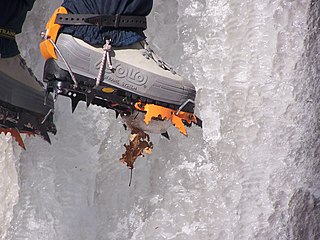
A crampon is a traction device attached to footwear to improve mobility on snow and ice during ice climbing. Besides ice climbing, crampons are also used for secure travel on snow and ice, such as crossing glaciers, snowfields and icefields, ascending snow slopes, and scaling ice-covered rock.
Marker International is a German manufacturing company of equipment for winter sports established in 1952 and headquartered in Straubing, Lower Bavaria. Founded by Hannes Marker, the company is known for pioneering releasable binding technology. Marker's first model, the Duplex was followed in 1953 by the Simplex toe binding which was a huge success in the 1950s. New models introduced in the 1980s were major competitors on the alpine racing circuit.
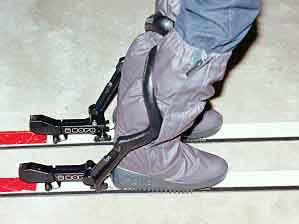
The Nava System was a ski binding and custom ski boot offered for sale in the 1980s. The system used a combination of flexible sole plate to keep the boot centered, and a spring-loaded plastic arm on the rear binding that was used to transmit sideways motions of the leg to the ski. This eliminated the need for a hard shell on the boot; the Nava boot was soft and resembled a knee-high winter boot. In spite of numerous endorsements by racing stars, the system never caught on and sales ended by the late 1980s.

Spademan was a type of ski binding, one of a number of "plate bindings" that were popular in alpine skiing during the 1970s. It used a bronze plate screwed into the bottom of the boot as its connection point, held to the ski by a clamp-like mechanism that grasped the side of the plate. Unlike conventional bindings, the Spademan could release in any direction, in response to any force or torque. It provided greatly improved protection compared to contemporary designs, which generally allowed release of the toe to the sides and heel directly forward, keeping the foot attached in any other fall direction.

Look's Nevada, released in 1950, was the first recognizably modern alpine ski binding. The Nevada was only the toe portion of the binding, and was used with a conventional cable binding for the heel. An updated version was introduced in 1962 with a new step-in heel binding, the Grand Prix. These basic mechanisms formed the basis for LOOK bindings for over 40 years, changing mainly in name and construction materials. The Nevada toe pattern is almost universal among bindings today.

Cable bindings, also known as Kandahar bindings or bear-trap bindings, are a type of ski bindings widely used through the middle of the 20th century. It was invented and brand-named after the Kandahar Ski Club in 1929 by ski racer and engineer Guido Reuge. They were replaced in alpine skiing by heel-and-toe "safety bindings" in the mid-1960s.
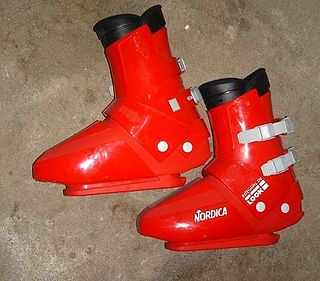
The Look Integral was a downhill ski binding that worked in conjunction with a custom ski boot made by Nordica. The Integral was fairly common in ski rental shops in the 1980s and into the 90s, but has since disappeared.
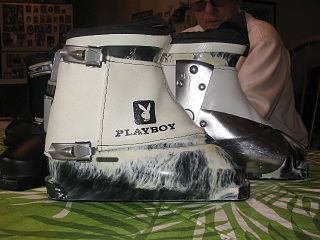
Rosemount Ski Boots introduced one of the earliest all-plastic ski boots for the downhill skiing market, competing with Bob Lange for the title of "first". Rosemount's design was easily distinguished by its use of the uncommon "side-entry" method for putting the boot on, which was rare at the time and is no longer used.

Lange is a major producer of ski boots used in alpine (downhill) skiing, founded in 1948 in the USA. They introduced the world's first plastic ski boots in 1962, and a greatly improved model aimed at the racing market in 1965. After several World Cup and Olympics wins in 1967 and 1968 made them a must-have on the circuit, Lange has remained a force in the racing market ever since. Their boots have equipped five times as many World Cup medal winners as any other brand into the 2000s. The front-entry design introduced by Lange is used by almost every modern ski boot to this day. Lange remains a major brand worldwide.

The Flexon was a downhill ski boot introduced by Raichle in the winter of 1980/81. Based on designs by Sven Coomer, Al Gross and Erik Giese, the Flexon used a unique system to control forward flex in a predictable way, as well as making the boot more comfortable and easier to put on and remove. The basic layout was, and is, generally referred to as a "three-piece" design -- three-piece boots preceding the Flexon included the Henke Strato, Nordica Comp 3 and a dozen other designs from Italian bootmakers.
This glossary of skiing and snowboarding terms is a list of definitions of terms and jargon used in skiing, snowboarding, and related winter sports.
References
- 1 2 Wright, Wesley Alan. "The University of Vermont: SKIVT-L: Ski Vermont Discussion List: Vermont Skiing Rules : Vermont Ski History Vault: Movie, Photos, Maps :". waw.w3.uvm.edu. Retrieved 2020-03-22.
- 1 2 "Burt Retractable". Skiing. December 1976.
- 1 2 Carr, Stanley (12 November 1972). "Ski Notes: Thinking the same at the Show". New York Times.
- 1 2 "BURTON WEINSTEIN - BINDING INVENTOR". Skiing History. 9 August 2013.
- ↑ Bryden, Allysun (1998). From Tip to Tail (PDF). Aspen Historical Society. pp. 35, 36.
- ↑ Needham, Richard (1987). Ski: Fifty Years in North America. Harry Abrams. p. 107.